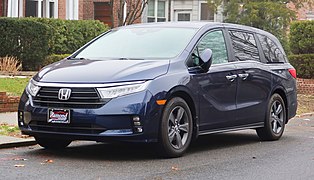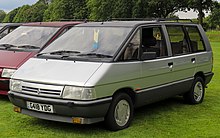Minivan

Minivan(sometimes called simply avan) is acar classificationfor vehicles designed to transport passengers in the rear seating row(s), with reconfigurable seats in two or three rows. The equivalent classification in Europe isMPV(multi-purpose vehicle) orM-segment- and are taller than asedan car,hatchback,SUVorstation wagon.[2][3][4][5]
Compared with afull-size van,most minivans are based on a passengercar platformand have a lower body. Early models such as theFord AerostarandChevrolet Astroutilized a compact pickup truck platform.[6][7]Minivans often have a 'one-box' or 'two-box'body configuration,a higher roof, a flat floor, sliding doors for rear passengers, and highH-pointseating. The largest size of minivans is also referred to as 'Large MPV' and became popular following the introduction of the 1984Dodge CaravanandRenault Espace.Typically, these have platforms derived from D-segment passenger cars or compact pickups. Since the 1990s, the smallercompact MPVandmini MPVsizes of minivans have also become popular.[8]
Though predecessors to the minivan date back to the 1930s, the contemporary minivan body style was developed concurrently by several companies in the early 1980s, most notably byChrysler(producer of theChrysler minivans) andRenault(theRenault Espace), both first sold formodel year1984. Minivans cut into and eventually overshadowed the traditional market of thestation wagonand grew in global popularity and diversity throughout the 1990s. Since the 2000s, their reception has varied in different parts of the world: in North America, for example, they have been largely eclipsed bycrossoversandSUVs,while in Asia they are commonly marketed asluxury vehicles.
Etymology
[edit]The termminivanoriginated in North America and the United Kingdom in 1959. In the UK, the Minivan was a small van manufactured by Austin based on the newly introduced Mini car. In the US, the term was used to differentiate the smaller passenger vehicles fromfull-size vans(such as the Ford E-Series, Dodge Ram Van, and Chevrolet Van), which were then called 'vans'.[9]
The first known use of the term was in 1959,[10]but not until the 1980s was it commonly used.
Characteristics
[edit]Chassis
[edit]In contrast to larger vans, most modern minivans/MPVs use a front-engine, front-wheel drive layout, while some model lines offer all-wheel drive as an option. Alongside adopting the form factor introduced byChrysler minivans,the configuration allows for less engine intrusion and a lower floor in the passenger compartment. In line with larger full-size vans, unibody construction has been commonly used (the spaceframe design of theRenault Espaceand theGeneral Motors APV minivansbeing exceptions).
Minivans/MPVs are produced on distinct chassis architecture or share platforms with other vehicles such as sedans andcrossover SUVs.Minivans do not have as much ground clearance, towing capacity, or off-road capability compared to SUVs.[11]Minivans provide more space for passengers and cargo than sedans and SUVs.[11]
Body style
[edit]
Minivans/MPVs use either atwo-boxor aone-boxbody design withA, B, C, and D pillars.The cabin may be fitted with two, three, or four rows of seats, with the most common configurations being 2+3+2 or 2+3+3. Compared to other types of passenger vehicles, the body shape of minivans is designed to maximize interior space for both passengers and cargo. It is achieved by lengthening thewheelbase,creating a flatter floor, taller roof, and more upright side profile, but not as prominent as commercial-oriented vans that are boxier in profile. Practicality and comfort for passengers are also enhanced with a larger rear cargo space opening and larger windows.[12]
Some minivans/MPVs may use sliding doors, while others offer conventional forward-hinged doors. Initially, a feature of the 1982Nissan Prairie,the 1996Chrysler minivansintroduced a driver-side sliding door; by 2002, all minivans were sold with doors on both sides of the body. Most minivans are configured with a rearliftgate;few minivans have used panel-style rear doors, for example, cargo versions of theChevrolet Astro,Ford Aerostar,and theMercedes-Benz V-Class.
Interior
[edit]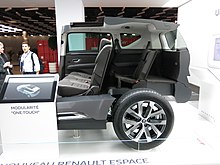
Most minivans have a reconfigurable interior to carry passengers and their effects. The first examples were designed with removable rear seats unlatched from the floor for removal and storage (in line with larger vans); however, users gave poor reception to the design as many seats were heavy and hard to remove. In 1995, theHonda Odysseywas introduced with a third-row seat that folded flat into the floor, which was then adopted by many competitors, includingChryslerthat introduced third-row andfold-flat second-row seatsin 2005.
High-end minivans may include distinguished features such as captain seats orOttoman seats,as opposed tobench seatsfor the second row.[13]
Predecessors
[edit]Before the adoption of theminivanterm, there is a long history of one-box passenger vehicles roughly approximating the body style,[14]with the 1936Stout Scaraboften cited as the first minivan.[15][16][17][18]The passenger seats in the Scarab were moveable and could be configured for the passengers to sit around a table in the rear of the cabin. Passengers entered and exited the Scarab via a centrally-mounted door.
TheDKW Schnellaster—manufactured from 1949 until 1962—featuredfront-wheel drive,atransverse engine,a flat floor, and multi-configurable seating, all of which would later become characteristics of minivans.[19]
In 1950, theVolkswagen Type 2adapted a bus-shaped body to the chassis of a small passenger car (the Volkswagen Beetle). When Volkswagen introduced a sliding side door to the Type 2 in 1968, it then had the prominent features that would later come to define a minivan: compact length, three rows of forward-facing seats, station wagon-style top-hinged tailgate/liftgate, sliding side door, passenger car base.[20]
The 1956–1969Fiat Multiplaalso had many features in common with modern minivans. The Multipla was based on the chassis of theFiat 600and had arear engineandcab forwardlayout.[21]
The early 1960s saw Ford and Chevrolet introduce "compact" vans for the North American market, theEconoline Club WagonandGreenbrierrespectively. The Ford version was marketed in theFalconseries, the Chevrolet in theCorvair95 series. The Econoline grew larger in the 1970s, while the Greenbrier was joined by (and later replaced by) theChevy Van.
-
Stout Scarab
(1936–1942) -
DKW Schnellaster
(1949–1962) -
Volkswagen Type 2
(1950–1967) -
Fiat 600 Multipla
(1956–1969)
North America
[edit]Due to their larger footprint and engines, minivans developed for the North American market are distinct from most minivans/MPVs marketed in other regions, such as Europe and Asia. As of 2020[update],average exterior length for minivans in North America ranged around 200 inches (5.08 m), while many models useV6engines with more than 270 horsepower (201 kW; 274 PS) mainly to fulfill towing capacity requirements which North American customers demand.[22][23]
In 2021, sales of the segment totalled 310,630 units in the U.S. (2.1% of the overall car market), and 33,544 in Canada (2.0% of the overall car market).[24][25]As of 2022[update],the passenger-oriented minivan segment consists of theToyota Sienna,Chrysler Pacifica,Chrysler Voyager,Honda Odyssey,andKia Carnival.[26]
- Top 3 best-sellers in the U.S., 2021
-
Toyota Sienna
(2020–present) -
Honda Odyssey
(2018–present) -
Chrysler Pacifica/Voyager
(2019–present)
History
[edit]1970s and 1980s
[edit]
In the late 1970s, Chrysler began a development program to design "a small affordable van that looked and handled more like a car."[27]The result of this program was the first American minivans based on theS platform,the 1984Plymouth VoyagerandDodge Caravan.[28]The S minivans debuted the minivan design features of front-wheel drive, a flat floor and a sliding door for rear passengers.[27][29][30]
The term minivan came into use largely compared to size tofull-size vans;at six feet tall or lower, 1980s minivans were intended to fit inside a typical garage door opening.[31]In 1984,The New York Timesdescribed minivans "the hot cars coming out of Detroit,"[32]noting that "analysts say the mini-van has created an entirely new market, one that may well overshadow the...station wagon."[32]
In response to the popularity of the Voyager/Caravan,General Motorsreleased the 1985Chevrolet AstroandGMC Safaribadge-engineered twins, and Ford released the 1986Ford Aerostar.These vehicles used a traditionalrear-wheel drivelayout, unlike the Voyager/Caravan.[31][33]
To match the launch of minivans by American manufacturers, Japanese manufacturers introduced theToyota Van,Nissan Vanette,andMitsubishi Delicato North America in 1984, 1986, and 1987, respectively. These vehicles were marketed with the generic "Van" and "Wagon" names (for cargo and passenger vans, respectively).[34][35]
In 1989, theMazda MPVwas released as the first Japanese-brand minivan developed from the ground up specifically for the North American market. Its larger chassis allowed an optional V6 engine and four-wheel drive to fit. In contrast to the sliding doors of American minivans, a hinged passenger-side door was used. A driver-side entry was added for 1996, as Mazda gradually remarketed the model line as an early crossover SUV.
By the end of the 1980s, demand for minivans as family vehicles had largely superseded full-size station wagons in the United States.[36]
1990s
[edit]
During the 1990s, the minivan segment underwent several significant changes. Many models switched to the front-wheel drive layout used by the Voyager/Caravan minivans. For example, Ford replaced the Aerostar with the front-wheel driveMercury Villagerfor 1993 and theFord Windstarfor 1995. The models also increased in size due to the extended-wheelbase ( "Grand" ) versions of the Voyager and Caravan, launched in 1987. An increase in luxury features and interior equipment was seen in the Eddie Bauer version of the 1988 Ford Aerostar, the 1990Chrysler Town & Country,and the 1990Oldsmobile Silhouette.The third-generation Plymouth Voyager, Dodge Caravan, and Chrysler Town & Country – released for the 1996 model year – had an additional sliding door on the driver's side.
Following the 1990 discontinuation of the Nissan Vanette in the United States, Nissan also ended the sale of the second-generationNissan Axxess.Nissan reentered the segment by forming a joint venture with Ford to develop and assemble a minivan that became theNissan Questand its Mercury Villager counterpart.
Toyota also introduced theToyota Previain 1990 to replace the Van/Wagon in North America. It was designed solely as a passenger vehicle sized to compete with American-market minivans. For 1998, theToyota Siennabecame the first Japanese-brand minivan assembled in North America, replacing the Toyota Previa in that market. For 1999, Honda introduced a separate version of theOdyssey for North America,with North America receiving a larger vehicle with sliding doors.
2000s and 2010s
[edit]
The highest selling year for minivans was in 2000, when 1.4 million units were sold. However, in the following years, sales of minivans began to decrease. In 2013, the segment's sales reached approximately 500,000, one-third of its 2000 peak.[37]Market share of minivans in 2019 reached around 2% after a steady decline from 2004, when the segment recorded above 6% of share.[38]It has been suggested that the falling popularity of minivans is due to the increasing popularity of SUVs and crossovers, and its increasingly undesirable image as a vehicle for older drivers or thesoccer momdemographics.[37][39][40]
From 2000 onward, several minivan manufacturers adopted boxier square-based exterior designs and began offering more advanced equipment, including power doors and liftgate; seating that folded flat into the cabin floor; DVD/VCR entertainment systems; in-dash navigation and rear-view camera (both only offered on higher-end trims); and parking sensors. However, the Quest and Sedona only echo these design changes in their third and second respective generations. At the same time, Chrysler introduced fold-flat seating in 2005 (under the trademark “Stow-n’-go” ). Mazda's MPV did not feature power doors and was discontinued in 2017.
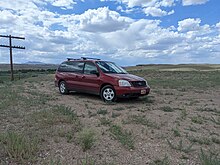
Due to the market decline, North American sales of theVolkswagen Eurovanceased in 2003. Ford exited the segment in 2006 when theFord Freestarwas canceled, Chrysler discontinued its short-wheelbase minivans in 2007, and General Motors left the market segment in 2009 with the cancellation of theChevrolet Uplander.However, Volkswagen marketed theVolkswagen Routan(a rebadgedChrysler RT minivans) between 2009 and 2013. In 2010, Ford started importing the commercial-orientedFord Transit ConnectWagon from Turkey. A similar vehicle, theMercedes-Benz Metris,entered the North American market in 2016.
TheKia Sedona,which was introduced for the 2002 model year, is notable for being the first minivan from a South Korean manufacturer in the region.[41]For 2007,Kiaalso introduced the three-rowKia Rondocompact MPV, where it was prominently marketed as a crossover due to its small size and the use of hinged rear doors.[42][43]
Another compact MPV released to the market was theMazda5in 2004, a three-row vehicle with rear sliding doors. Mazda claimed the model "does not fit into any traditional (North American) segmentation."[44]TheFord C-Maxwas released for 2013 as ahybrid electricandbattery electriccompact MPV with sliding doors. However, it did not offer third-row seating in North America.[45][46]
Europe
[edit]This sectionneeds additional citations forverification.(February 2022) |
In Europe, the classification is commonly known as "MPV", "people carrier",[47]or officially M-segment,[3][4][5]and includesvan-based vehicles and smaller vehicles with two-row seating.[48][49]
History
[edit]1980s
[edit]The 1984Renault Espacewas the first European-developed minivan developed primarily for passenger use (as the earlier DKW and Volkswagen used their commercial van platforms in a minibus variant). Beginning development in the 1970s under the European subsidiaries of Chrysler,[50]the Espace was intended as a successor for theMatra Rancho,leading to its use of front-hinged doors. While slow-selling at the time of its release, the Espace would become the most successful European-brand minivan.[51]
Initially intending to market the Espace in North America throughAmerican Motors Corporation(AMC), the 1987 sale of AMC to Chrysler canceled the plans for Renault to do so. In the late 1980s, Chrysler and Ford commenced sales of American-designed minivans in Europe (categorized as full-size in the region), selling theChrysler Voyagerand Ford Aerostar. General Motors imported the Oldsmobile Silhouette (branded as the Pontiac Trans Sport), later marketing the American-producedOpel/Vauxhall Sintra.
1990s
[edit]In the 1990s, several joint ventures produced long-running minivan designs. In 1994,badge engineeredseries ofEurovanswas introduced, produced bySevel Nordand marketed by Citroën, Fiat, Lancia, and Peugeot. The Eurovans were built with two sliding doors; the gearshift was located on the dashboard to increase interior space, and a petal-type handbrake was adopted. In 1995, Ford of Europe and Volkswagen entered a joint venture, producing theFord Galaxy,SEAT Alhambra,andVolkswagen Sharanminivans, featuring front-hinged rear side doors.
In 1996, Mercedes introduced theMercedes-Benz V-Classas a standard panel van for cargo (called Vito) or with passenger accommodations substituted for part or all of the load area (called V-Class or Viano). In 1998, theFiat Multiplawas released. A two-row, six-seater MPV with a 3+3 seat configuration borrowing its name froman older minivan,it is notable for its highly controversial design.[52]
Market reaction to these new full-size MPV models was mixed. Consumers perceived MPVs as large and truck-like despite boasting similar footprints as large sedans. Arguably, cultural reasons regarding vehicle size and high fuel prices were a factor. During 1996 and 1997, the Western European MPV market expanded from around 210,000 units to 350,000 units annually. However, the growth did not continue as expected, resulting in serious plantovercapacity.[53]
Renault set a new "compact MPV" standard with theRenault Scénicin 1996, which became popular. Based on the C-segmentMéganeplatform, it offered the same multi-use and flexibility aspects as the larger MPVs but with a much smaller footprint.[53]
2000s
[edit]After the success of the Renault Scénic, other makers have developed similar European-focused products, such as theOpel Zafirathat offered three-row seating,Citroën Xsara Picassoand others.[53]
Asia
[edit]Japan
[edit]This sectionneeds additional citations forverification.(February 2022) |
In Japan, the classification is known as "minivan"(Japanese:ミニバン,Hepburn:Miniban)and defined by its three-row seating capacity.[54][55]
Before the birth of minivans with modern form factors, tall wagon-type vehicles with large seating capacity in Japan were known as light vans. They commonly adoptedmid-engine,cab overdesign, and rear-wheel drive layout with one-box form factor. Examples included theToyota TownAce,Toyota HiAce,Nissan Vanette,Mitsubishi DelicaandMazda Bongo.These vehicles were based on commercial vehicles, which created a gap compared to sedans regarding ride quality and luxury.[56]
TheNissan Prairie,released in 1982, is considered the first Japanese compact minivan.[57]Derived closely from a compact sedan, the Prairie was marketed as a "boxy sedan", configured with sliding doors, folding rear seats, and a lifting rear hatch.[56]TheMitsubishi Chariotadopted nearly the same form factor, instead using wagon-style front-hinged doors.
In 1990, Toyota introduced theToyota Estimain Japan, which carried over the mid-engine configuration of the TownAce.[58][59]Along with its highly rounded exterior, the Estima was distinguished by its nearly panoramic window glass.[60]The Estima was redesigned in 2000, adopting a front-wheel drive layout and offered with ahybridpowertrain since 2001.[61]In 2002, Toyota introduced theToyota Alphardwhich was developed as a luxury-oriented model. In 2020, Lexus introduced their firstluxuryminivan, theLexus LM,produced with varying degrees of relation with the Toyota Alphard/Vellfire. The LM designation stands for "Luxury Mover".[62][63]
Nissan introduced theNissan Serenain 1991 and theNissan Elgrandin 1997.
In 1995, Honda entered the minivan segment by introducing theHonda Odyssey.[64]The Odyssey was designed with front-hinged doors and as derived from the Honda Accord. It came with advantages such as sedan-like driving dynamics and a lower floor to allow for easy access.[56]In a design feature that would become widely adopted by other manufacturers, the Odyssey introduced a rear seat that folded flat into the floor (replacing a removable rear seat). The Odyssey evolved into a low-roof, estate-like minivan until 2013, when it adopted a high-roof body with rear sliding doors.[65]Honda also produced theHonda Stepwgnmid-size MPV since 1996, which is designed with a higher cabin and narrow width, and theHonda Streamsince 2000 to slot below the Odyssey.[66][67]
In 2020, minivans made up 20.8% of total automobile sales in Japan, behind SUVs and compact hatchbacks, making it one of the largest minivan markets in the world.[68]
South Korea
[edit]In South Korea, both the terms "minivan" and "MPV" are used.[69]TheKia Carnival(also sold the Kia Sedona) was introduced in 1998 with dual sliding doors. Sharing its configuration with the Honda Odyssey, theHyundai Trajetwas sold from 1999 to 2008. Introduced in 2004, theSsangYong Rodiusis the highest-capacity minivan, seating up to 11 passengers. It was discontinued in 2019.
Current minivans marketed in South Korea are the Kia Carnival and Hyundai Staria, along with imported options such as the Toyota Sienna (originally for North America) and later generations of Honda Odyssey.[69]
China
[edit]

In 1999,Shanghai GMcommenced production of theBuick GL8minivan, derived from a minivan platform designed by GM in the United States. After two generations of production, the GL8 is the final minivan produced by General Motors or its joint ventures today. It remained dominant in the high-end minivan segment of the market.[70]
Sales of minivans in China increased rapidly in 2015 and 2016 when the Chinese government lifted theone-child policyin favor of thetwo-child policy,which pushed customer preference toward three-row vehicles in anticipation of a larger family. In 2016, 2,497,543 minivans were sold in China, a major increase from 2012, which recorded 936,232 sales. However, sales volume has shrunk ever since, with only 1,082,028 minivans sold in the domestic market in 2021 (4.1% of the total car market), around 720,000 of which were sold by domestic manufacturers.[70][71][72]
In August 2022,Zeekrintroduced theZeekr 009electricminivan,[73]deliveries of the 009 began in the first quarter of 2023 in China.[74]
Indonesia
[edit]The MPV segment is the most popular passenger car segment in Indonesia, with a market share of 40 percent in 2021.[75][76][77]
India
[edit]The category is commonly known asmulti utility vehicle (MUV)or MPV.[78][79]Infiscal year2020, the sales volume of the segment totaled 283,583 vehicles, or 10.3% of industry total.[80][81]
Luxury MPV
[edit]Manufacturers such asMercedes-Benz,Toyota,Lexus,Buick,Hongqi,ZeekrandVolvohave marketed upscale MPVs asluxury vehicles,mainly marketed for several Asian (especially Chinese) markets.
Luxury MPVs generally have 3-rows of six or seven seats; however, range-topping flagship models may also offer a 2-rows option with four seats, which typically have more features than their cheaper counterparts. By the early 2020s, manufacturers have found additional strategies to improve technologies, such as new materials, new systems, and improving exteriors.
Examples of luxury MPV models includeMercedes-Benz V-Class,Lexus LM,Buick GL8,Hongqi HQ9,Toyota Alphard,Volvo EM90and theZeekr 009.[82][83]
- Examples of upscale MPVs
-
Mercedes-Benz EQV
(2020–present) -
Lexus LM
(2020–present) -
Hongqi HQ9
(2022–present) -
Volvo EM90
(2023–present)
Size categories
[edit]Mini MPV
[edit]
Mini MPV – an abbreviation for Mini Multi-Purpose Vehicle – is a vehicle size class for the smallest size of minivans (MPVs). The Mini MPV size class sits below the compact MPV size class, and the vehicles are often built on the platforms of B-segment hatchback models.
Several minivans based on B-segment platforms have been marketed as 'leisure activity vehicles' in Europe.[84]These include theFiat FiorinoandFord Transit Courier.[85]
Examples:Category:Mini MPVs( 70 )
Compact MPV
[edit]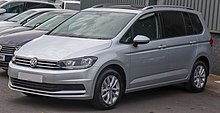
Compact MPV – an abbreviation for Compact Multi-Purpose Vehicle – is a vehicle size class for the middle size of MPVs/minivans. The Compact MPV size class sits between the mini MPV and minivan size classes.
Compact MPVs remain predominantly European, although they are also built and sold in many Latin American and Asian markets. As of 2016, the only compact MPV sold widely in the United States was the Ford C-Max.
Examples:Category:Compact MPVs( 112 )
Related categories
[edit]Leisure activity vehicle
[edit]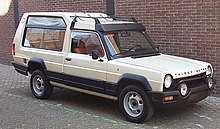

Aleisure activity vehicle(abbreviatedLAV), also known as van-based MPV[86]andludospacein French,[87]is the passenger-oriented version of small commercial vans primarily marketed in Europe.[84]One of the first LAVs was the 1977Matra Rancho(among the first crossover SUVs and a precursor to the Renault Espace), with European manufacturers expanding the segment in the late 1990s, following the introduction of theCitroën BerlingoandRenault Kangoo.
Leisure activity vehicles are typically derived fromsuperminiorsubcompactcar platforms, differing frommini MPVsin body design. To maximize interior space, LAVs feature a taller roof, more upright windshield, and longer hood/bonnet with either aliftgateor barn doors to access the boot. Marketed as an alternative to sedan-derivedsmall family cars,LAVs have seating with a lowerH-pointthan MPVs or minivans, offering two (or three) rows of seating.
Though sharing underpinnings with superminis, subcompacts, and mini MPVs, using an extended wheelbase can make leisure activity vehicles longer than those from which they are derived. For example, theFiat Doblòis one of the longest LAVs with a total length of 4,255 mm (167.5 in), versus the 4,050 mm (159.4 in) of theOpel Meriva(a mini MPV) and the 4,030 mm (158.7 in) of thePeugeot 206SW (a supermini).
Asian utility vehicle
[edit]
AnAsian utility vehicle(abbreviatedAUV) originates from the Philippines to describe basic and affordable vehicles with either large seating capacity or cargo designed to be sold in developing countries. These vehicles are usually available in minivan-like wagon body style with a seating capacity of 7 to 16 passengers. They are usually based on a compact pickup truck withbody-on-framechassis andrear-wheel driveto maximize its load capacity and durability while maintaining low manufacturing costs. Until the 2000s, AUVs were popular in Southeast Asia, particularly in Indonesia, the Philippines, Taiwan, and some African markets.[88]
The first AUV is theToyota Tamaraw/Kijang,introduced in the Philippines and Indonesia in 1975 as a pickup truck with an optional rear cabin.[89]In the 1990s, other vehicles such as theIsuzu Panther/Hi-Lander/CrosswindandMitsubishi Freeca/Adventure/Kudaemerged in the AUV segment.[90]Modern equivalent of AUV is theToyota Innova,an MPV that is the direct successor to the Kijang which in its first two generations were built with body-on-frame construction. The vehicle's third generation switched tounibodyconstruction.[91]
Three-row SUV
[edit]With the decline of the minivan/MPV category in many regions, such as North America and Europe, in the mid-2010s, SUVs and crossovers with three rows of seating became popular alternatives. Compared to minivans, three-row SUVs lose sliding doors and generally offer less interior space due to the higher priorities on exterior styling and higherground clearance.[92][93][94]
References
[edit]- ^"Ranked: 5 best-selling new minivans in the U.S. in 2020".AutomotiveMap. 10 August 2020.Retrieved17 January2021.
No. 1 - Chrysler Pacifica (93,802 sold)
- ^"minivan".Cambridge Advanced Learner's Dictionary & Thesaurus.Cambridge University Press.Retrieved30 May2017.
- ^ab"Regulation (EEC) No 4064/89 - Merger Procedure"(PDF).ec.europa.eu.Luxemburg: Office for Official Publications of the European Communities. 17 March 1999. p. 2.Retrieved3 March2019.
- ^ab"Car prices within the European Union / Prix des voitures au sein de l'Union européenne / Autopreise in der europäischen Union"(PDF).ec.europa.eu(in English, French, and German). Brussels: Publications Office of the European Union. 1 January 2011.Retrieved3 March2019.
- ^ab"Impact on the Competitiveness of the European Automotive Industry of Potential FTA with India and ASEAN"(PDF).europa.eu.p. 8. Archived fromthe original(PDF)on 29 April 2013.
- ^Taylor, Rich (February 1990)."The Light Vantastics".Popular Mechanics.Vol. 167, no. 2. p. 64.Retrieved17 September2020.
- ^"Mass Transit".Popular Mechanics.Vol. 164, no. 11. November 1987. p. 72.Retrieved17 September2020.
- ^"Our pick: Top 10 used mini-MPVs".Auto Trader.3 August 2010. Archived fromthe originalon 5 March 2012.Retrieved28 February2012.
- ^Sorokanich, Robert (2 November 2013)."30 Years Ago Today, Chrysler Invented the Minivan, And Changed History".Gizmodo.Retrieved2 May2016.
- ^"Definition of Minivan".merriam-webster.Retrieved30 March2019.
- ^abTrompete, Tara (13 October 2023)."SUV or Minivan: Which Should You Choose?".Kelly Blue Book.Retrieved17 May2024.
- ^"What is an MPV?".buyacar.co.uk.Retrieved4 March2022.
- ^Max, Josh (28 July 2020)."Five Minivans You Shouldn't Be Embarrassed [sic] To Drive".Forbes.Retrieved26 July2022.
- ^Benjamin Hunting (21 January 2021)."GM's X-Cars: Anatomy of a Miserable Failure".Motor Trend.
- ^Patton, Phil (6 January 2008)."A Visionary's Minivan Arrived Decades Too Soon".The New York Times.Retrieved6 September2014.
- ^Ernst, Kurt (11 July 2013)."Cars of Futures Past – Stout Scarab".Hemmings.Retrieved26 July2022.
- ^"Revisiting Classics: The Stout Scarab".drivezing.23 August 2018.Retrieved30 March2019.
- ^"The Stout Scarab is the World's First Minivan, and the First Car with a Mustache".tflcar.19 May 2018.Retrieved30 March2019.
- ^Niedermeyer, Paul (29 March 2010)."The Mother Of All Modern Minivans: 1949 DKW Schnellaster".The Truth About Cars.Retrieved2 December2020.
- ^Kindy, David (6 March 2020)."How the Volkswagen Bus Became a Symbol of Counterculture".Smithsonian Magazine.Retrieved2 December2020.
- ^Mattews, Nigel (26 November 2014)."Fiat invented minivan concept with the Multipla".Driving Canada.Retrieved2 December2020.
- ^"Common Minivan Dimensions".J.D. Power.Retrieved4 March2022.
- ^"What's the Best Minivan or SUV for Towing a Travel Trailer?".Togo RV.16 December 2020.Retrieved4 March2022.
- ^"US car sales analysis 2021 – Minivans".carsalesbase.20 January 2022.Retrieved2 March2022.
- ^Tulumba, Chris."2021 Canada Minivan Sales Figures By Model".goodcarbadcar.net.Retrieved3 March2022.
- ^"Best New Minivans and Vans of 2022".Car and Driver.4 February 2022.Retrieved2 March2022.
- ^ab"America on the Move - Dodge Caravan".Smithsonian Institution - National Museum of American History.Retrieved2 May2016.
- ^Zatz, David (16 November 2020)."Creating the Plymouth, Dodge, and Chrysler Minivan: The Caravan/Voyager Development Story".Allpar.Retrieved26 July2022.
- ^"The Ford Mustang and the minivan have an amazing shared history".Business Insider.Retrieved31 March2019.
- ^"Coolest Minivans of All Time".autoblog.Retrieved31 March2019.
- ^abStepler, Richard (February 1985)."New generation minivans".Popular Science.Vol. 226, no. 2. pp. 74–75.Retrieved2 May2016.
- ^abKurczewski, Nick (15 December 2016)."Driving Down Memory Lane in the Original Minivan".The New York Times.Retrieved2 May2017.
- ^Lamm, Michael (April 1985)."PM drives GM's new minivan".Popular Mechanics.Vol. 162, no. 4. pp. 48, 168.Retrieved23 October2018.
- ^"Autotrader - page unavailable".autotrader.Retrieved2 March2022.
- ^"A Van By Any Other Name: Mitsubishi" Wagon "".oldmotors.net.23 November 2019.Retrieved2 March2022.
- ^"Best of the Minivans".Kiplinger's Personal Finance.Vol. 44, no. 7. July 1990. p. 41.Retrieved26 December2015.
- ^abEisenstein, Paul A. (10 May 2014)."'Mom mobiles' a shrinking category for automakers ".CNBC.Retrieved26 December2015.
- ^"Minivan Market Share Is Now at 2 Percent In America, and It's Rapidly Getting Worse".The Truth About Cars.18 February 2020.Retrieved6 March2022.
- ^Neil, Dan (17 October 2007)."Head of the Family".Los Angeles Times.Archived fromthe originalon 29 July 2018.
- ^Cheney, Peter (27 September 2011)."Minivans are perfect. Why do we hate them?".The Globe and Mail.Retrieved6 March2022.
- ^Bedard, Patrick (1 October 2001)."Kia Sedona".Car and Driver.Retrieved2 March2022.
- ^"Kia Rondo found! And reviewed".Autoblog.Retrieved2 March2022.
- ^"2007 Kia Rondo".topspeed.1 December 2006.Retrieved2 March2022.
- ^Barry, Keith."Review: Mazda 5".Wired.ISSN1059-1028.Retrieved4 March2022.
- ^"Ford cancels seven-passenger C-Max for U.S., focuses solely on Hybrid and Energi models".autoblog.Retrieved4 March2022.
- ^Healey, James R."Test Drive: Ford C-Max is eco-licious fun".USA Today.Retrieved4 March2022.
- ^"Top 100 Cars 2014: Top 10 MPVs (people carriers)".Driving.co.uk from The Sunday Times.25 October 2014.Retrieved11 June2022.
- ^"History of Toyota's compact MPV models".mag.toyota.co.uk.1 April 2015.Retrieved2 March2022.
- ^"What is an MPV (multi-purpose vehicle)?".parkers.co.uk.Retrieved2 March2022.
- ^Lewin, Tony (2003).How to Design Cars Like a Pro: A Complete Guide to Car Design from the Top Professionals.Motorbooks International.ISBN0-7603-1641-4.
- ^"Renault Espace, this is your life".topgear.23 April 2015.Retrieved3 April2019.
- ^"The 100 ugliest cars: 20-1".telegraph.co.uk.28 August 2008.
- ^abc"The reasons why full-size minivans don't sell in Europe".just-auto.30 May 2000.Retrieved15 August2023.
- ^"トヨタ の ミニバン"[Toyota minivans].toyota.jp.Retrieved2 March2022.
- ^"【2022 năm 】ミニバンおすすめ người khí 15 tuyển |価 cách ・スペック tương đối |Motor-Fan[モーターファン]"[[2022] 15 Recommended Popular Minivans | Price / Spec Comparison].car.motor-fan.jp.Retrieved2 March2022.
- ^abc"ミニバン văn hóa の phát triển ( 1994 năm )"[Development of minivan culture (1994)].gazoo(in Japanese). 31 January 2014.Retrieved2 March2022.
- ^Giao thông タイムス xã."ミニバン の ルーツは thừa dùng xe の đẻ ra モデル! Âu châu では chiến trước より lên sân khấu"[The roots of the minivan are derivative models of passenger cars! Appeared in Europe before the war].automesseweb.jp(in Japanese).Retrieved2 March2022.
- ^"Nhật Bản ミニバン giới の thuỷ tổ sơ đại エスティマが khởi こした cách mạng"[The revolution caused by the first Estima, the founder of the Japanese minivan world].Tự động xe tình báo chí “ベストカー”(in Japanese). 10 February 2021.Retrieved2 March2022.
- ^Schefler, Jim (September 1983)."Toyota's mini-van".Popular Science.Vol. 223, no. 3. p. 123.Retrieved23 October2018.
- ^"【エスティマ, オデッセイ… Hắn 】 thời đại を変えた cá tính phái “Danh” ミニバン6 tuyển "[[Estima, Odyssey... etc.] 6 unique minivans that changed the times].Tự động xe tình báo chí “ベストカー”(in Japanese). 21 March 2020.Retrieved2 March2022.
- ^Giao thông タイムス xã (9 May 2020)."Số nhiều く の モデルが ra đời! トヨタ・グランエースへ続くトヨタが sinh み ra したミニバン の lịch sử を siêm る"[Many models are born! Tracing the history of Toyota-created minivans following the Toyota Granace].webcartop.jp(in Japanese).Retrieved2 March2022.
- ^"Lexus LM luxury MPV fully revealed ahead of UK launch".Autocar.Retrieved10 June2023.
- ^Sarne, V. Vernon B."The Lexus Luxury Mover makes a lot of motoring sense".visor.ph.Retrieved10 June2023.
- ^"ホンダ “オデッセイ” が27 năm の lịch sử に mạc! “ミニバン” ブーム の hỏa phó け dịch が tàn した công tích とは ".くるま の ニュース(in Japanese).Retrieved2 March2022.
- ^"Tiêu えちゃいけないオデッセイが5 đại mục にして tiêu diệt! ミニバン thị trường をけん dẫn した vĩ đại なる1 đài の lịch sử とは | goo - tự động xe"[The Odyssey that cannot disappear for the 5th generation! What is the history of one great car that drove the minivan market?].goo tự động xe &バイク(in Japanese).Retrieved2 March2022.
- ^"ミニバンとは? Hắn にはないミニバン の lương さや mới nhất người khí xe loại をご giới thiệu! ( WEB CARTOP )".Yahoo!ニュース(in Japanese).Retrieved2 March2022.
- ^"Đệ 38 hồi: ミニバン văn hóa の phát triển quảng さと đi り の lạng lập に chọn んだ25 năm"[Development of minivan culture 25 years of striving to achieve both wideness and driving].webcg.net(in Japanese). 6 December 2018.Retrieved2 March2022.
- ^"SUV の シェアがミニバン siêu え の 3 cắt に! Thế lực đồ が đại 変 hóa した xe mới thị trường の nay とは!?|コラム【MOTA】"[The share of SUVs exceeds 30% of minivans! What is the current state of the new car market, where the power map has changed dramatically?].autoc-one.jp MOTA ( cũ オートックワン )(in Japanese).Retrieved2 March2022.
- ^ab"여름 휴가의 이상적인 동반자, 국내서 만날 수 있는 MPV 6종"[The ideal companion for summer vacation, 6 MPVs that you can meet in Korea].motoya.co.kr 모토야(in Korean). 28 July 2021.Retrieved7 March2022.
- ^ab"〈 Will 〉 tái kia" tỷ muội xe "Tới, còn sẽ tiếp tục đi" tăng giá "Lộ tuyến sao 『 vương miện 』? _ tân nguồn năng lượng thị trường _ linh bài phóng trí năng ô tô võng".0car.top.Retrieved27 February2022.
- ^"Chinese-owned MPV brands see decline in market share - China.org.cn".china.org.cn.Retrieved6 March2022.
- ^"China: passenger car sales by model 2021".statista.Retrieved6 March2022.
- ^de Feijter, Tycho (9 August 2022)."Zeekr 009 Is A New Electric MPV For The Chinese Car Market".CarNewsChina.Archivedfrom the original on 20 September 2022.Retrieved27 September2022.
- ^"ZEEKR 001's monthly deliveries hit new high in Aug. 2022".Gasgoo.1 September 2022.Archivedfrom the original on 27 September 2022.Retrieved27 September2022.
- ^"Automotive Manufacturing Industry Indonesia".indonesia-investments.Netherlands. 2 April 2018.Retrieved27 February2022.
- ^"Gaikindo reveals five popular car brands in Indonesia in 2017".The Jakarta Post.Indonesia. 21 January 2018.Retrieved27 February2022.
- ^Elvira, Vina (4 November 2021)."Pangsa pasar segmen MPV capai 40%, ini kata Gaikindo".newssetup.kontan.co.id(in Indonesian).Retrieved6 March2022.
- ^"MUV Cars".zigwheels.Retrieved6 March2022.
- ^"MPV Cars in India".autocarindia.Retrieved6 March2022.
- ^Punditz, Team Auto (8 April 2020)."MUV Sales in India for FY2020".autopunditz.Retrieved6 March2022.
- ^Punditz, Team Auto (4 April 2020)."FY2020 Car Sales in India – Snapshot".autopunditz.Retrieved6 March2022.
- ^Misoyannis, Alex (20 September 2023)."2024 Lexus LM price and specs: Luxury people-mover tops $220,000".drive.au.
- ^"Coming soon: the Volvo EM90, our first ever fully electric premium MPV".Volvo Cars Official Website(Press release). 24 August 2023.
- ^abPatrascu, Daniel (13 February 2018)."PSA Previews New Generation Leisure Activity Vehicles (LAV)".autoevolution.Retrieved21 October2018.
- ^"Ford Transit Courier: Small Fiesta-based van".topgear-autoguide.4 September 2013.Retrieved2 March2022.
- ^"Peugeot Rifter revealed as Citroen Berlingo Multispace sibling".autocar.co.uk.Retrieved4 March2022.
- ^Dieter (16 July 2018)."LAVs rise above their van origins and enter fleets".fleeteurope.Retrieved4 March2022.
- ^"From humble beginnings: The History of the Asian Utility Vehicle".c-magazine.10 December 2021.Retrieved27 February2022.
- ^"The AUV: In the service of the Filipino - Feature Stories".autoindustriya.12 June 2015.Retrieved27 February2022.
- ^"Adios, AUVs: The twilight of the 10-seaters is upon us".topgear.ph.Retrieved4 March2022.
- ^"AUV, MPV, or SUV: What are the differences?".autodeal.ph.26 April 2019.Retrieved27 February2022.
- ^"3 Row SUV vs the Best Minivan: Which is Right For You?".agirlsguidetocars.28 January 2022.Retrieved4 March2022.
- ^Radu, Vlad (30 April 2021)."A Minivan or a Three-Row SUV? Which Vehicle Is Better for Your Family?".autoevolution.Retrieved4 March2022.
- ^"Minivan or SUV—Which Is Best for Big Families?".Motor Trend.23 April 2020.Retrieved4 March2022.
External links
[edit]- Videos
- "The Fall of the Minivan".CNBC. 18 September 2019.Archivedfrom the original on 11 December 2021.Retrieved24 November2020– via YouTube.






